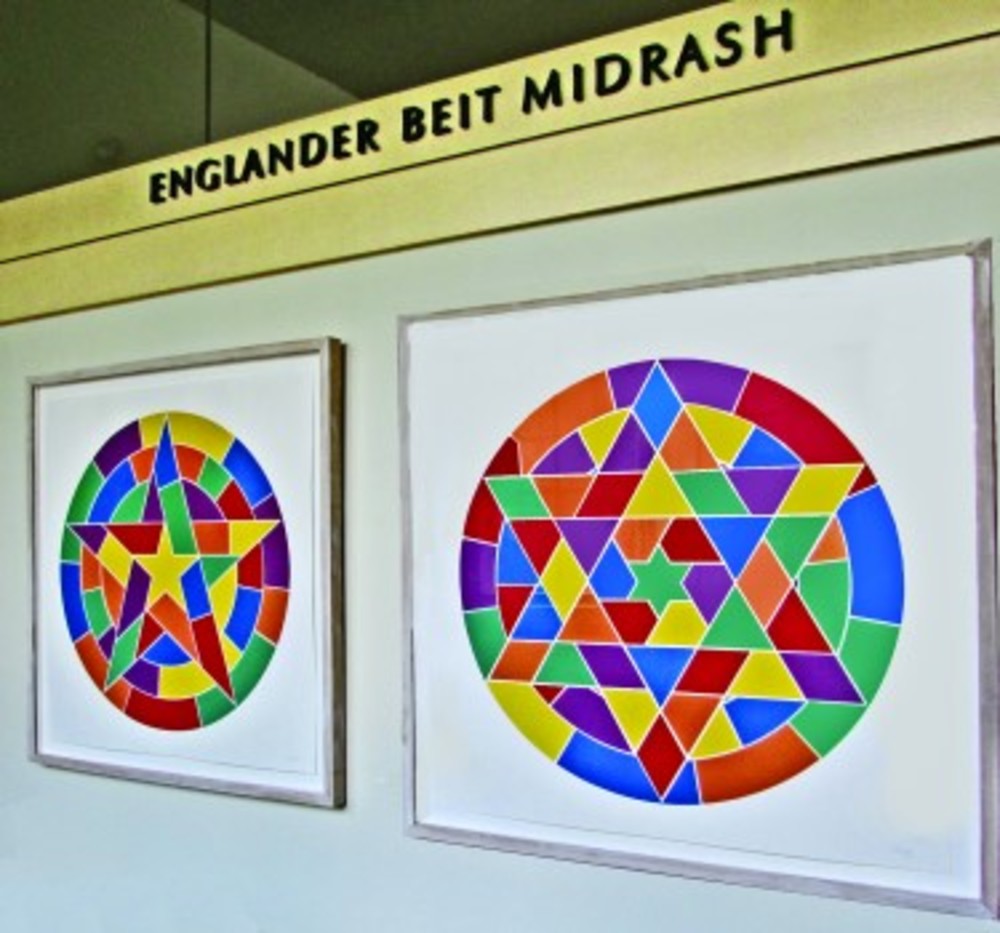Four prints at Brown RISD Hillel
 The prints outside Hillel’s Englander Beit Midrash. /George GoddwinThis year marks the 10th anniversary of Brown University’s Glenn & Darcy Weiner Center. Through the integration of three historic structures under a common roof, this may be America’s most imaginatively designed Hillel house. Numerous donors and two architectural firms – Haynes/de Boer of Providence and the Babcock Group of Salt Lake City – deserve our gratitude.
The prints outside Hillel’s Englander Beit Midrash. /George GoddwinThis year marks the 10th anniversary of Brown University’s Glenn & Darcy Weiner Center. Through the integration of three historic structures under a common roof, this may be America’s most imaginatively designed Hillel house. Numerous donors and two architectural firms – Haynes/de Boer of Providence and the Babcock Group of Salt Lake City – deserve our gratitude.
The Weiner Center also is notable for the display of numerous works of art. Many belong to temporary exhibitions shown in the first-floor gallery. Other works of varying size, media and quality are scattered among offices, hallways, alcoves and two sanctuaries.
I am particularly intrigued by a set of four handsomely framed prints (actually linocuts) created in 2002 by Sol LeWitt (1928-2007), a prominent and prolific American-Jewish artist. Each signed print, 27 by 27 inches, is the last impression in an edition of only 10.
I caught a glimpse of LeWitt’s cerebral work in 1967, quite early in his career, at the Los Angeles County Museum of Art. Soon it became familiar to me at many New York museums, the Walker Art Center in Minneapolis, Minnesota, and the Wadsworth Athenaeum in his native Hartford, Connecticut. In 1993, after seeing his immense retrospective exhibition of murals, which he called “wall drawings,” at the Addison Gallery of American Art, in Andover, Massachusetts, I became a huge fan. My recent visit to see more than 100 of his “wall drawings” at MASS MoCA, in North Adams, Massachusetts, left me even more enthralled.
Our RISD Art Museum has many LeWitt prints and drawings, the first acquired in 1974, which typically explore geometric patterns and shapes without alluding to metaphorical content. The museum also owns an austere wooden sculpture, about 7 feet high, wide, and deep, which resembles a modular city or a three-dimensional equation. Presently on display in the Chase Wing’s lobby is a somber “wall drawing,” based on a 1980 schema, which, I think, is underwhelming.
Each of LeWitt’s prints at Brown RISD Hillel has a striking central image: an encircled geometric shape energized by vivid primary and secondary colors. Perhaps the opposite is also true: bright colors define an encircled shape. Each print represents a progression in geometric complexity: from a shape with only three points in the first print to one with seven in the last. Inevitably, the six-pointed shape, especially when viewed at Hillel, resembles a Jewish star.
A key attribute of LeWitt’s art is either its purity or anonymity. There’s no evidence of a smudge, a wayward line or a hurried passage. His art is primarily one of conceptualization. Accordingly, assistants or students have executed most of LeWitt’s drawings, prints, murals and sculptures according to his specifications. Much of his own apprenticeship consisted of studying art while a guard at The Museum of Modern Art.
It’s a valid question whether LeWitt’s objects are illuminating, elusive or, possibly, both. Do they demonstrate spatial and perceptual truths or are they merely amusing riddles and puzzles? I would never argue that LeWitt probes the heart’s heights or depths, but he has achieved something curious and compelling – perhaps magical.
Unfortunately, LeWitt’s four prints on the Weiner Center’s fourth floor are not displayed sequentially. Two, with five- and six-pointed stars, are hung, appropriately, near the entrance to the Englander Beit Midrash, but a third is located in a nearby corner. Like a stepchild, the fourth print is relegated to the foyer of the Dorenbaum Library.
Surprisingly, the LeWitt prints were not purchased for the Weiner Center. Originally gifts of Robert Feldman, class of 1958, the linocuts are on long-term loan from Brown’s David Winton Bell Gallery.
It’s debatable, however, whether LeWitt’s art is adaptable to any context. For example, the American Embassy in Berlin has a huge “wall drawing” inside its main entrance. The predominant shapes are five-pointed stars: one brightly colored, the other black and white. But are these American stars or simply eye-catching motifs? Opposite the embassy’s entrance is a vast work by another American Jew: Peter Eisenman’s architectural sculpture, Memorial to the Murdered Jews of Europe, which was dedicated in 2005. What do LeWitt’s stars mean when seen from this context?
As a member of Beth Shalom Rodfe Zedek, a Reform congregation in Chester, Connecticut, LeWitt was invited to design its synagogue, which was completed in 2001. Once again, the artist brought forth a concept, which was executed by an architect, Stephen Lloyd. The sanctuary, resembling in its stark, geometric framework the destroyed wooden synagogues of Poland, serves as a subtle Holocaust memorial. By contrast, LeWitt’s painted ark decoration, consisting of an encircled, six-pointed star, seems far too obvious. Its bold colors feel carnivalesque.
With these paragraphs, I’d like to bury a hatchet. In the late 1920s, my paternal grandfather and one of LeWitt’s relatives, probably an uncle, were engravers and angry rivals in New Britain, Connecticut. They probably belonged to the same shul, B’nai Israel, but gave up speaking to one another. Today, however, both families can enjoy Sol’s renown.
George Goodwin, a member of Temple Beth-El, has edited the “Rhode Island Jewish Historical Notes” for 10 years.
Editor’s Note: This article is part of a series about Hiddur Mitzvah (enhancement or beautification of the Divine Commandment).







